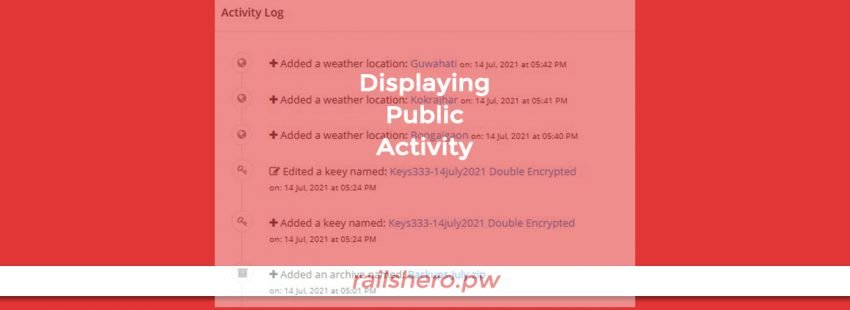Activity Logs
An activity log is a record of logs that track user actions performed in an app. Activity logs are useful, because if something goes wrong, an user can check their activity log and see where they messed things up. Activity logs are common in social media sites like facebook, even github has one.

And This is the activity log of my app which i use for weather research.

The public activity gem
We can display public activity in our app by building such kind of functionality from scratch. But to make life easier, there is a ruby gem called ‘public_activity’ that comes with its own methods to display public activity logs easily in our rails app. This gem displays activity logs that is very similar to Github’s activity logs. Also you can customize the look of your logs however you want, this gem already comes with methods to exactly do that.
Public Activity Github Page: https://github.com/chaps-io/public_activity
To add activity logging with public activity
So, in order to add activity logs, follow the steps below.
1. Add public activity to your Gemfile and run bundler
#File: Gemfile
gem 'public_activity'bundle install2. Now generate and run the migrations, this is only required if you are using active record.
rails g public_activity:migrationrails db:migrateThis will create a new table called ‘activities’ with the following columns.

3. The Model
Make your model trackable by public activity, this is my weather model
#File: app/models/weather.rb
class Weather < ApplicationRecord
include PublicActivity::Model
tracked
belongs_to :user
end4. The Controller
Now in your controller, i.e the controller where you want to display your public activity, add the activities instance variable so that you can query and display activities from your views. For instance, i want to display my activity logs in my Pages/Index page, so i’ll add it in my PagesController’s index action. Please note that i used kaminari for pagination, so i added the per page param. Check out my blog post on kaminari, if you are new to it.
#File: app/controllers/pages_controller.rb
class PagesController < ApplicationController
#...Other Methods...
def index
unless signed_in?
redirect_to new_user_session_path
else
@activities = PublicActivity::Activity.order("created_at DESC").page(params[:page]).per(12)
end
end
#...Other Methods...
end5. The Views
Now in my pages’ index view, i added an activity stream that will display the activities/actions performed by all users. I also added pagination, so that it shows only a few activities per page.
#File: app/views/pages/index.html.erb
<div class="activity-stream">
<% @activities.each do |activity| %>
<%= render_activity activity %>
<% end %>
</div>
<div class="pagination">
<%= paginate @activities %>
</div>6. The Partials
The above view will display activities with the most basic view, that means it will display all activities with no styles and no line breaks so it will look jumbled up. We need to fix that by adding different partials for different activities performed (such as create, update and destroy).
Public activity looks for view in: app/views/public_activity
So, go ahead and create a new folder in your ‘views’ directory and name it ‘public_activity’.
Now, since my model name is ‘weather’ i will create a new folder inside app/views/public_activity and name it ‘weather’. Name this folder with the name of your model, for instance if your model name is ‘book’ name it ‘book’
Now, in this directory/folder, i.e; app/views/public_activity/weather. I will create 3 new partials for each action, i.e; create, update and destroy. I customized the look of my partials by adding fontawesome and a few basic styles, you can customize it however you want. These partials will display the activity name, city_name(specific to my weather app), activity created/updated/destroyed timestamps, etc. You can also add other details that you want to display, Please check out Public Activity Github page for more info
The Create Partial
This partial will be displayed whenever a new record is created/added.
#File: app/views/public_activity/weather/_create.html.erb
<div class="stream">
<div class="stream-badge">
<i class="fa fa-globe"></i>
</div>
<div class="stream-panel">
<div class="stream-info">
</div>
<% if activity.trackable %>
<i class="fa fa-plus"></i>
Added a weather location: <%= link_to truncate(activity.trackable.city_name, :length => 71), activity.trackable %>
<small><span class="date">on: <%= activity.created_at.strftime('%d %b, %Y at %I:%M %p') %></span></small>
<% else %>
<i class="fa fa-window-close"></i>
Added a weather location, which has been removed
<small><span class="date">on: <%= activity.created_at.strftime('%d %b, %Y at %I:%M %p') %></span></small>
<% end %>
</div>
</div>The Update Partial
This partial will be displayed whenever an existing record is updated/edited.
#File: app/views/public_activity/weather/_update.html.erb
<div class="stream">
<div class="stream-badge">
<i class="fa fa-globe"></i>
</div>
<div class="stream-panel">
<div class="stream-info">
</div>
<% if activity.trackable %>
<i class="fa fa-edit"></i>
Edited a weather location: <%= link_to truncate(activity.trackable.city_name, :length => 71), activity.trackable %>
<small><span class="date">on: <%= activity.created_at.strftime('%d %b, %Y at %I:%M %p') %></span></small>
<% else %>
<i class="fa fa-window-close"></i>
Edited a weather location, which has been removed
<small><span class="date">on: <%= activity.created_at.strftime('%d %b, %Y at %I:%M %p') %></span></small>
<% end %>
</div>
</div>The Destroy Partial
This partial will be displayed whenever an existing record is destroyed/deleted.
#File: app/views/public_activity/weather/_destroy.html.erb
<div class="stream">
<div class="stream-badge">
<i class="fa fa-globe"></i>
</div>
<div class="stream-panel">
<div class="stream-info">
</div>
<i class="fa fa-window-close"></i>
Removed a weather location
<small><span class="date">on: <%= activity.created_at.strftime('%d %b, %Y at %I:%M %p') %></span></small>
</div>
</div>Final Thoughts
You can also use a separate layout for your @activities, and it supports i18n as well. You can even create your own custom activities such as ‘user commented on’, ‘user flagged post’, ‘user liked post’, etc. And apart from active record, public activity also supports Mongoid and MongoMapper, please read the documentation; if you want to do so.

1 thought on “Displaying Public Activity with public_activity gem”